A Short answer: Cardinals typically nest in dense shrubs, trees, or bushes. At night, they seek shelter in these same locations, settling within the protective cover of foliage to roost and rest.
Much like the myriad species that have carved their niche in the tapestry of nature, the avian world boasts a breathtaking diversity, with each bird bringing its unique song and color to the panorama.
At the forefront of this vivid spectacle is the Northern Cardinal. With the male’s fiery red attire and the female’s subtle brownish-red elegance, they have etched an indelible mark on the North American landscape, making them an emblem of our natural heritage.
In this comprehensive guide, we will embark on an enlightening journey, delving into the mysteries of cardinal nighttime nesting behaviors, and exploring the nuances that make these birds truly remarkable.
Inside This Cardinal Chronicle:
- Location Insights: Discovering the ideal nesting sites
- Safety First: Strategies to protect and appreciate cardinal nests
- Feeding Patterns: What keeps these vivid birds chirping?
Note: The subsequent insights aim to illuminate the natural behaviors and tendencies of the Northern Cardinal in their habitats. This is not a guide for domesticating or altering their wild essence. The cardinal, as with every creature, should be respected and allowed to flourish in its natural state. Whether observed in our backyards or in the wild, the well-being of these vibrant birds should always be our top priority.
Nighttime Nesting Habits of Cardinals
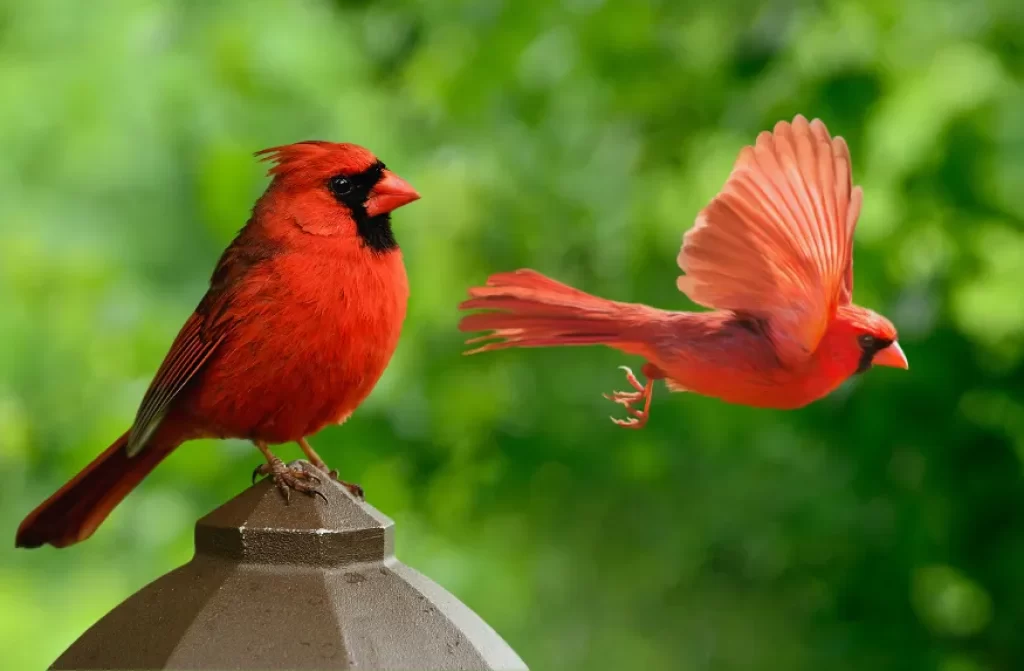
Where Do Cardinals Nest at Night?
Cardinals typically nest in dense shrubs, thickets, or low trees, preferring areas with a mix of branches for perching and dense foliage for cover.
At night, cardinals will roost in these same types of areas to remain concealed from predators. The chosen spot offers them protection from the elements and potential threats, ensuring they’re safe during their resting hours.
What Do Cardinals Do At Night?
Cardinals, like many other songbirds, are diurnal, which means they are active during the day and rest at night. At night, cardinals will seek out sheltered places to roost. These places might include dense shrubs, trees, or other areas that provide protection from predators and the elements.
The choice of roosting spot can be influenced by factors such as weather, predation threats, and habitat availability.
During the colder months, they might tuck their beaks into their wing feathers to conserve warmth. It’s also worth noting that cardinals, being monogamous, might roost close to their mates during the breeding season.
Their nighttime hours are primarily for resting and conserving energy for the following day’s activities which include foraging for food, defending territories, and, during the breeding season, caring for their young.
Cardinal Nest Characteristics
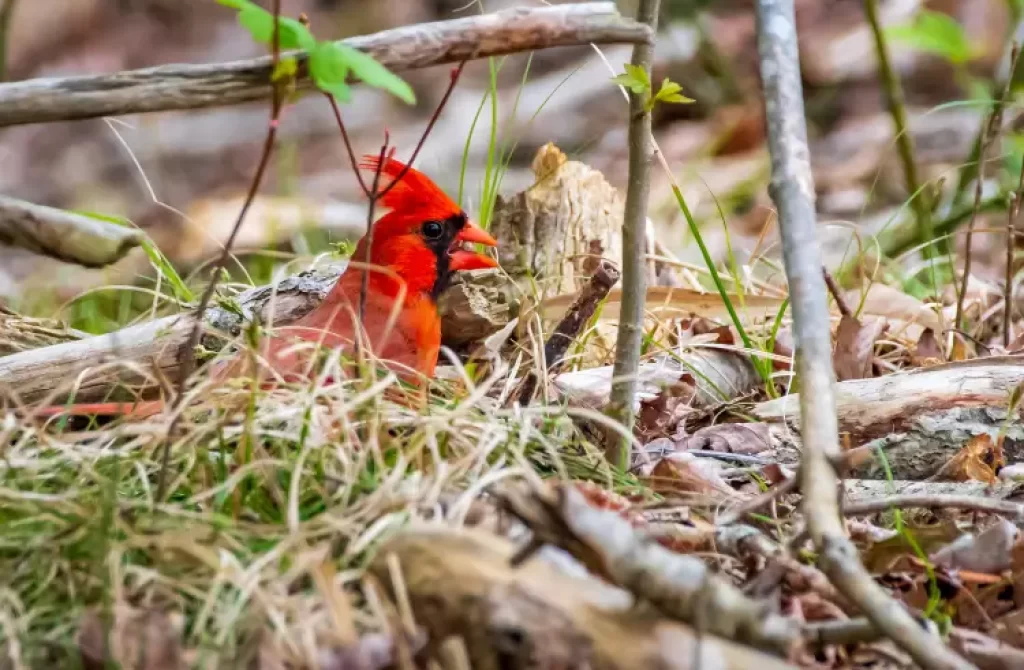
Structure and Material
Cardinals build nests that look like small bowls or cups. They use twigs, long grass, and leaves to make the outer part. Inside, they add soft things like moss, feathers, or bits of fur to make it cozy and warm for their eggs and chicks.
Location Preferences
Cardinals aren’t big fans of super high places. They usually pick places between 3 to 10 feet off the ground for their nests. Think about it like them choosing the middle branches of trees or bushes.
They especially like bushy plants where they can hide, like those big yellow forsythia bushes or rose bushes that are full of branches and leaves. This helps them stay hidden from anything that might want to bother them or their babies.
Where Do Cardinals Nest at Night info-graphic

How to Safeguard Cardinal Nests
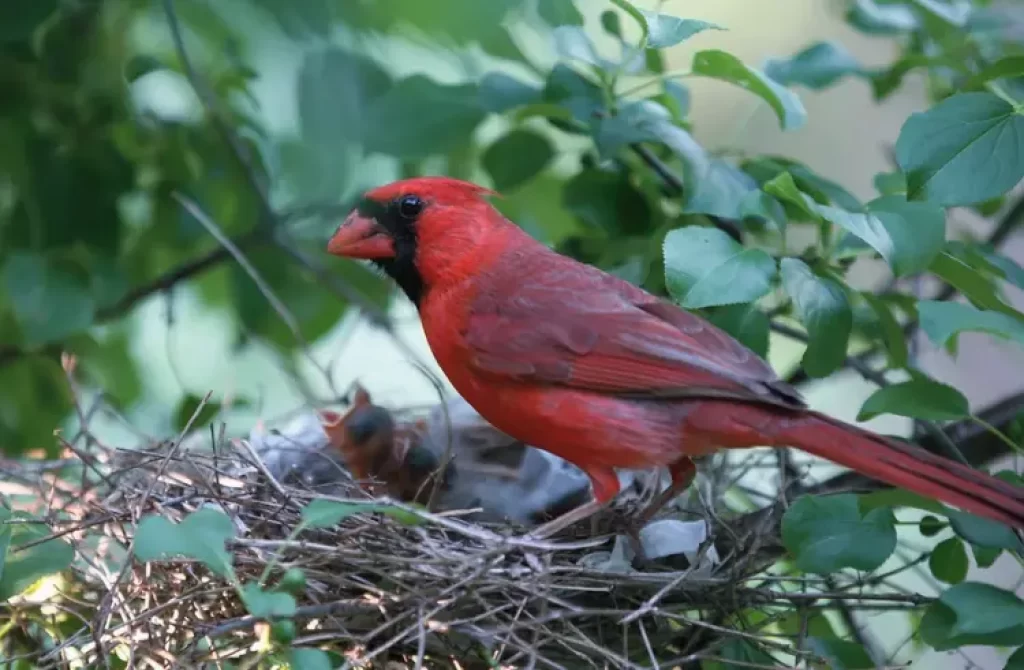
Limiting Disturbances:
You know, if you’re lucky enough to spot a cardinal nest in your yard, it’s really a privilege. However, you’d want to be super careful not to disturb these beautiful birds. Remember, they can be pretty sensitive. It’s a good idea to steer clear of their space, keep the noise down, and avoid any sudden moves that might scare them.
Keeping Pets in Check
Got pets? Especially those curious cats? Well, they might find a cardinal nest intriguing. But for the safety of the cardinals, try keeping your pets inside or under a watchful eye when they’re outside. We all love our furry friends, but they can unintentionally pose a danger to nesting birds.
Watching Out for Natural Predators
Nature has its circle of life, and while cardinals are stunning, they’re not at the top of the food chain. Other critters, like crows, blue jays, squirrels, and even snakes, might fancy a cardinal egg or two. One way to help these cardinals out is by arranging your bird feeders and garden plants thoughtfully. It could make all the difference in deterring potential nest raiders.
How do cardinals protect their nests and young during the night?
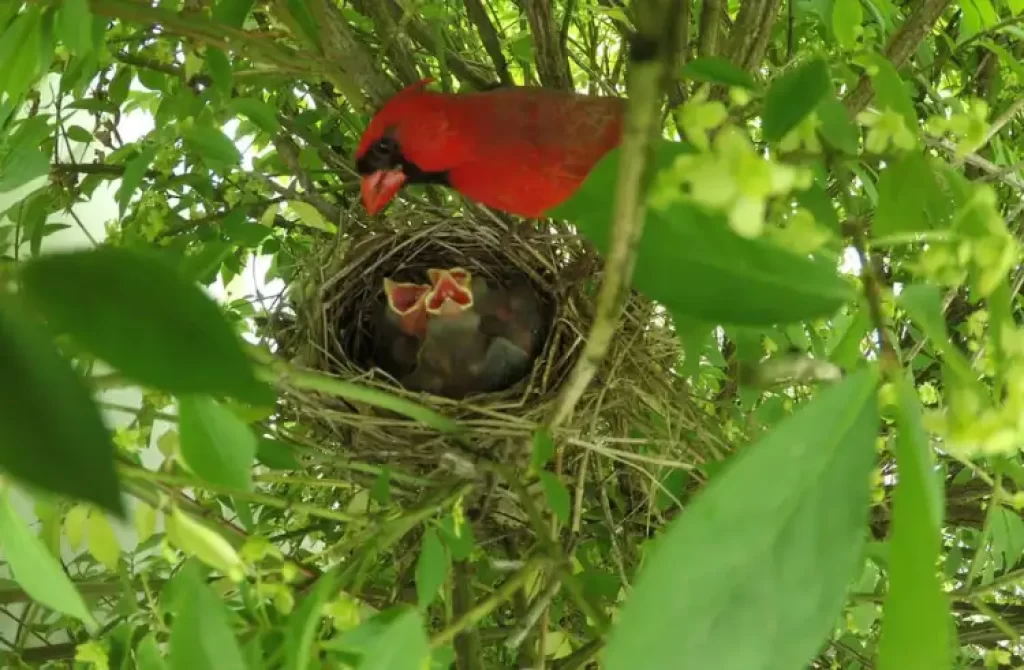
Cardinals, renowned for their vivid plumage and melodious calls, exhibit a blend of instinctual behaviors to safeguard their nests and fledglings. Predominantly, they select nesting sites within dense shrubbery or foliage, offering natural concealment from nocturnal predators.
This strategic placement not only masks the nest but also provides a barrier against unwanted intruders. At night, the cardinal family maintains a low profile, with both chicks and parents staying quiet to avoid detection. When threats do approach, adult cardinals are known for their fierce territoriality.
They won’t hesitate to issue alarm calls or even confront larger birds and animals to defend their offspring.
The nest’s subtle coloring, along with the young’s muted hues, further acts as a camouflage, blending seamlessly into the environment. In the grand scheme, these protective tactics are cardinal’s natural response to the ever-present challenges of the wild.
How to Attract Cardinals to Your Garden
Check out the video below for a step-by-step guide on how to make your garden a cardinal haven. Plus, we’ve got some pro tips to supercharge your efforts and make these gorgeous birds feel right at home in your yard.
Offering the Right Food
Cardinals are pretty simple when it comes to their diet, and seeds are their go-to. If you’re keen on having them frequent your garden, consider filling up your feeders with their favorites like sunflower seeds, safflower seeds, and even a bit of cracked corn. And here’s a fun tip: they have a sweet beak too! Toss in some fruits and berries, and watch them enjoy a treat.
Setting Up Water Spots
Ever seen a cardinal have a splash? It’s a sight! If you set up a birdbath or even a little fountain, cardinals will be more than happy to drop by. They don’t just come in for a sip; they love to bathe and preen, making these water sources an attractive pit-stop.
Offering a Cozy Hideout
Cardinals are big fans of privacy when it comes to settling down. They look for those cozy, dense spots to build their nests. So, if you’re thinking of gardening, invest in some dense shrubs and smaller trees. Even better if they’re native plants! They offer cardinals a familiar feel, making your garden feel just like home to them.
Common Questions About Cardinals
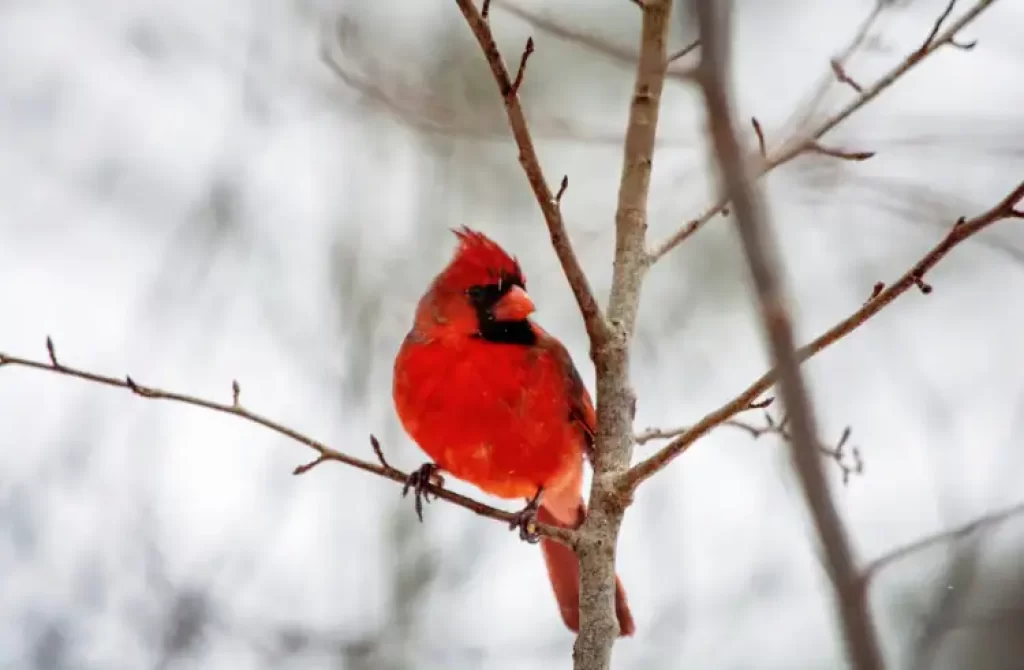
Do cardinals migrate at night?
Cardinals are generally considered non-migratory birds, meaning they typically stay in the same region year-round. However, there can be some limited movement, especially among younger birds or during particularly harsh winters, but these movements are not the long-distance migrations seen in many other bird species.
For birds that do migrate, many choose to do so at night. Nighttime migration offers advantages like cooler temperatures, calmer air, and reduced visibility to daytime predators. Additionally, some birds use stars for navigation.
But since cardinals don’t engage in regular, long-distance migrations, there isn’t a pattern of them traveling extensively at night. They typically remain in their territories or home ranges, which they defend year-round, especially during the breeding season.
Why do I see cardinals at my feeder in the evening?
Cardinals are known for being early risers and late feeders. It’s not uncommon to spot them at feeders during the twilight hours, seeking a meal before settling in for the night.
Conclusion
By gaining insights into the nocturnal habits and nesting preferences of cardinals, we empower ourselves as avid bird enthusiasts. This knowledge not only deepens our appreciation for these stunning birds but also equips us to create a nurturing sanctuary within our gardens and backyards, harmoniously coexisting with these feathered residents

Can Birds eat Popcorn Kernels?
Kenno Marques is a self-taught English speaker deeply passionate about nature and wildlife. He dedicates his time to scouring the web for the latest animal news and engaging content, which he shares on various websites. Fluent in three languages, Kenno is currently on a journey to master German. His commitment to fostering an understanding of the natural world makes him a valuable contributor to the online community.




